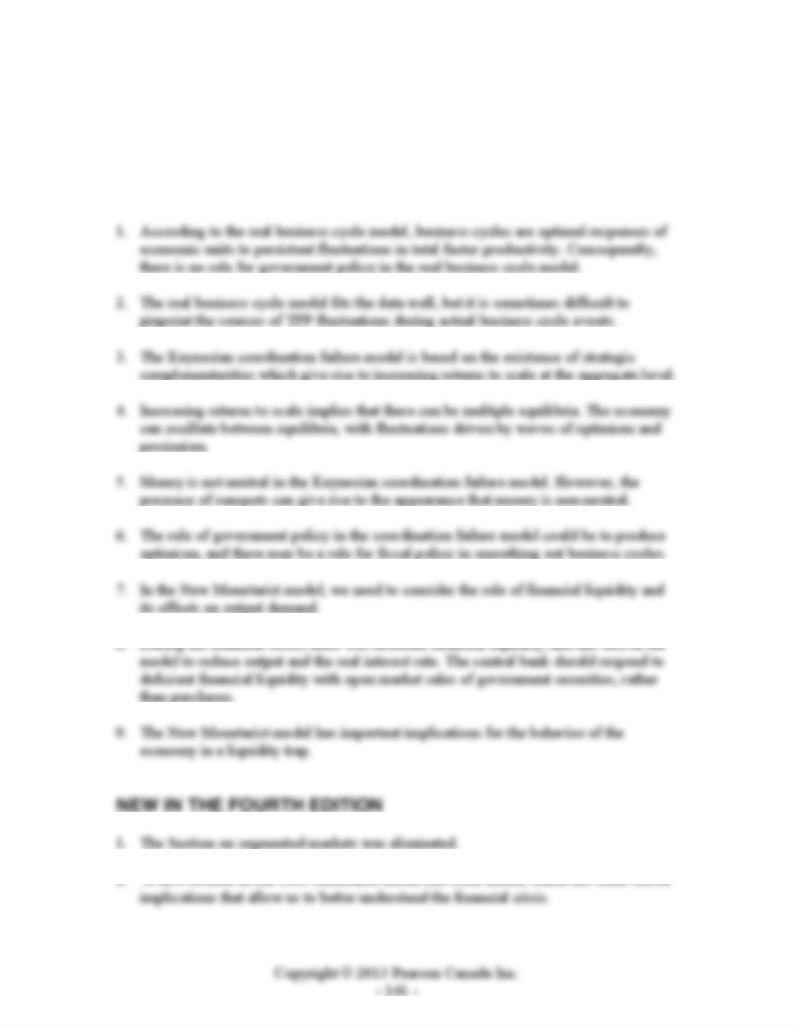
CHAPTER 13
Business Cycle Models with Flexible Prices and Wages
KEY IDEAS IN THIS CHAPTER

Instructor’s Manual for Macroeconomics, Fourth Canadian Edition
5. New end-of-chapter problems.
TEACHING GOALS
Chapter 3 demonstrated there are strong regularities associated with the comovements
among macroeconomic variables. Though business cycles are remarkably similar,
understanding their causes is a difficult task. There are multiple alternative business cycle
models, and students need to understand how these models are different – in terms of
what causes business cycles in these alternative models, and what the policy prescriptions
are. In need not be the case that we want to totally dismiss any business cycle models.
Potentially many models could give us useful insight what business cycles are about.
The models in this chapter are all based on flexible wages and prices. Sometimes these
are called “equilibrium” models, but even models with sticky wages and prices – for
example the New Keynesian model in Chapter 14 – have some notion of equilibrium. It is
important for students to understand, in spite of the fact that much of Keynesian
economics is done with sticky-wage-and-price models, that Keynesian ideas do not
depend on sticky wages and prices.
There are three elements in any business cycle model that are important: the impulses
(shocks), the propagation mechanism, and the policy conclusions. In the real business
cycle (RBC) model, the impulses are shocks to total factor productivity (TFP), these
shocks are propagated through the optimizing choices that are made by economic agents,
and in the baseline model there is no role for policy. In the Keynesian coordination
failure model the impulses are endogenous – self-confirming optimism and pessimism.
Propagation occurs in the same way as in the RBC model, but there may be a role for
government policy in improving matters. Either model fits the data as well as the other.
The last model in this chapter is a New Monetarist model, which is included to capture
specifically some features of the financial crisis, rather than as a general model of
business cycles. The novelty is the idea that financial liquidity is important in financial
crises, and that this requires a different way of thinking about monetary policy.
CLASSROOM DISCUSSION TOPICS
A key idea in this chapter is that a preliminary evaluation of a model’s usefulness
involves fitting the data. It would be good to discuss why this is valid. Might we imagine
models that did not fit the data well but might nevertheless be useful? Do we want the
model to fit all the data? Surely a model intended for the study of business cycles need
not give good predictions about the price of orange juice ten years from now.
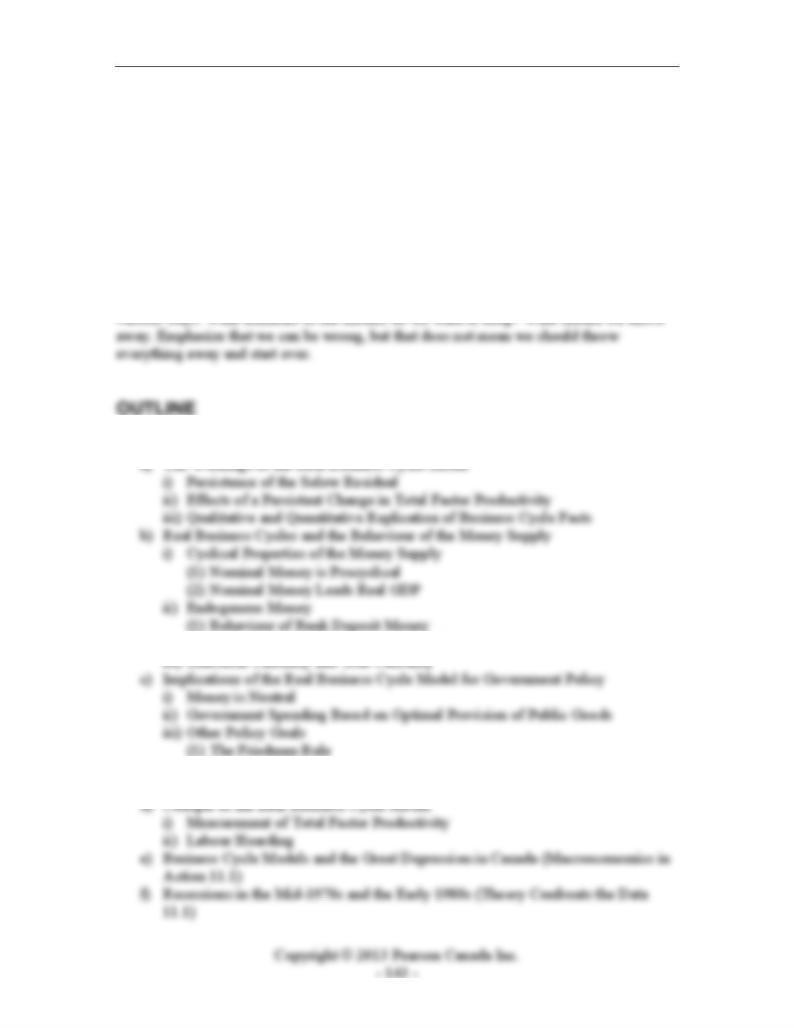
Chapter 13: Business Cycle Models with Flexible Wages and Prices
Macroeconomists have been criticized for not foreseeing the financial crisis. Would that
have been feasible? Is forecasting all the macroeconomists do? Point out that an
important goal in macroeconomics is to design models that can be useful for policy
analysis.
Why should we study different business cycle models? Surely they cannot all be correct.
Discuss how policymakers use models to make policy decisions. The models need to be
simple. There can be many factors at work in the real world, but putting these all in one
model may just be confusing.
One could have a discussion about the recent financial crisis and recession, and what the
models in this chapter had to say about it. Possibly these approaches missed the boat in
1. The Real Business Cycle Model
(2) Central Banks and Price-Level Stabilization
(2) The Smoothing of Tax Distortions
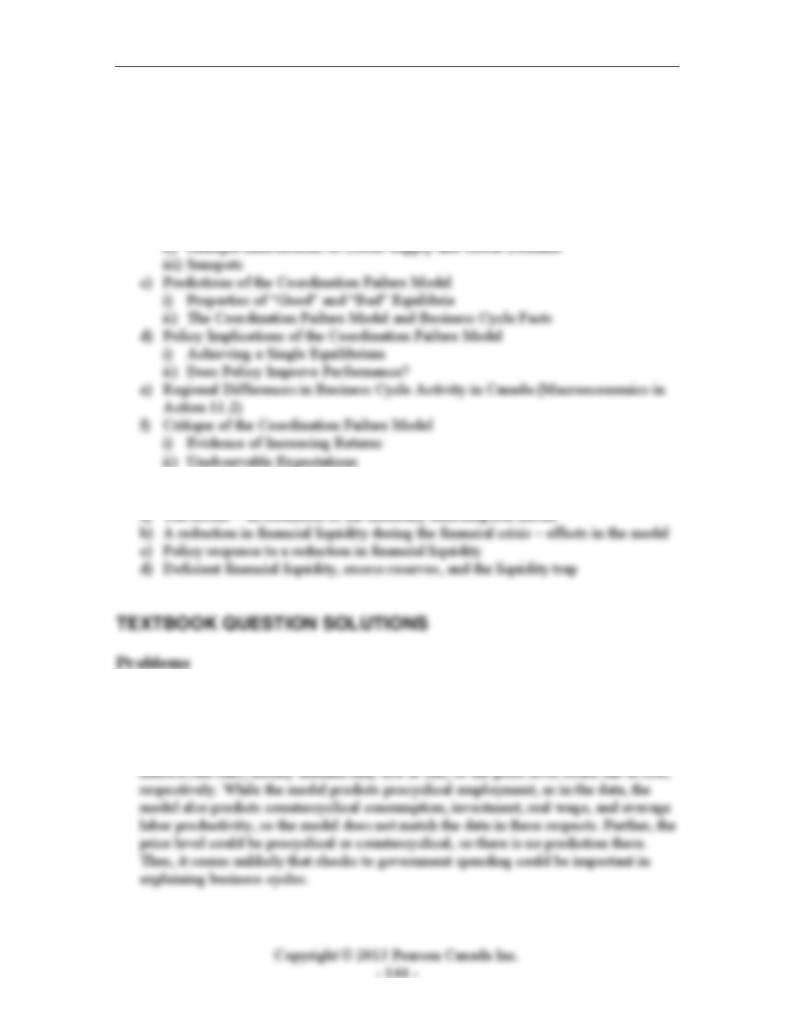
Instructor’s Manual for Macroeconomics, Fourth Canadian Edition
2. A Keynesian Coordination Failure Model
a) The Workings of the Model
i) Coordination Failures
ii) Strategic Complementarities
iii) Multiple Equilibria
iv) Increasing Returns to Scale
b) The Coordination Failure Model: An Example
i) The Downward-Sloping Goods Supply Curve
3. A New Monetarist Model: Financial Crises and Deficient Liquidity
1. The effects in the goods and labor markets are identical to what we considered in
Chapter 11. Output increases, the real interest rate rises, consumption and investment
fall, employment rises, and the real wage falls. What we need to add to the Chapter 11
analysis are the effects in the money market. Since output increases and the real
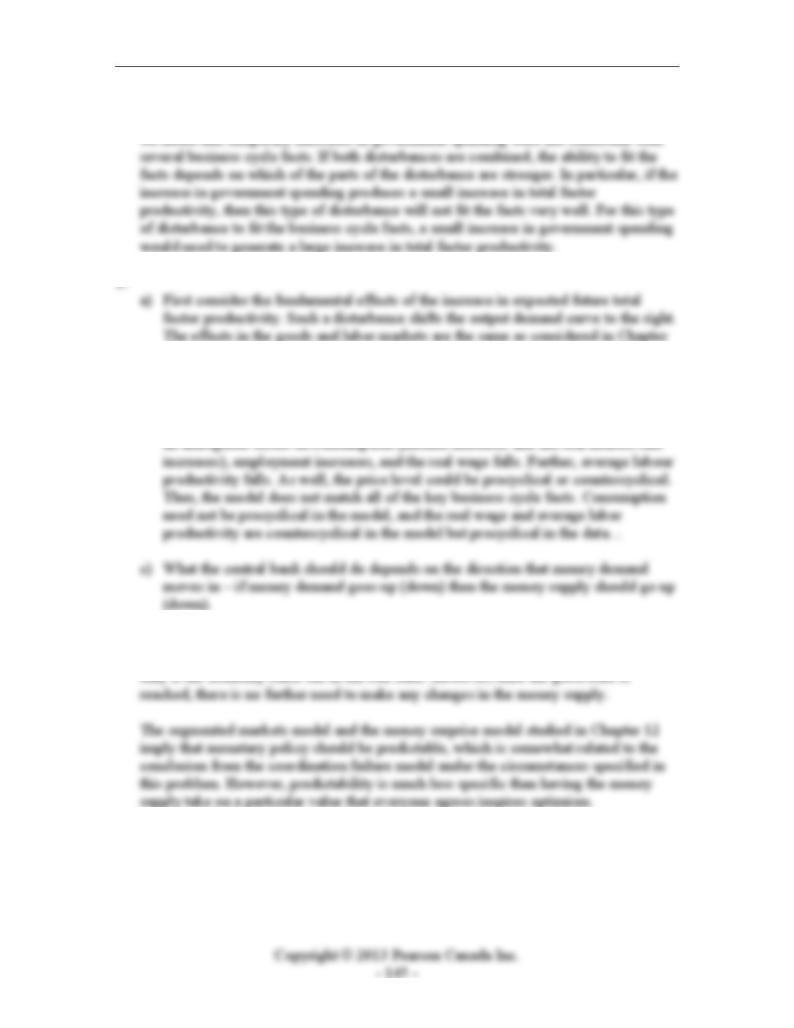
Chapter 13: Business Cycle Models with Flexible Wages and Prices
2. We already know that permanent increases in total factor productivity are consistent
with all of the business cycle facts. As developed in the answer to problem 1, above,
11. Here, we need to add the effects in the money market. Since output increases
and the real interest rate increase, the net effect on money demand is ambiguous,
so the price level could rise or fall.
b) From Chapter 11, we know that this shock causes investment to increase, there is
4. If the money supply were the only variable that shifts the economy between the bad
and good states, the monetary authority would need to increase the money supply
5. This shock acts to shift the labor supply curve to the right which, when we construct
the output supply curve, implies a shift to the left in that curve. As well, because there
is an increase in the demand for consumption goods, the output demand curve shifts
to the right. As shown in Figure 13.1, output in the good equilibrium increases, and
the real interest rate is lower in the good equilibrium. Thus, in the good equilibrium,
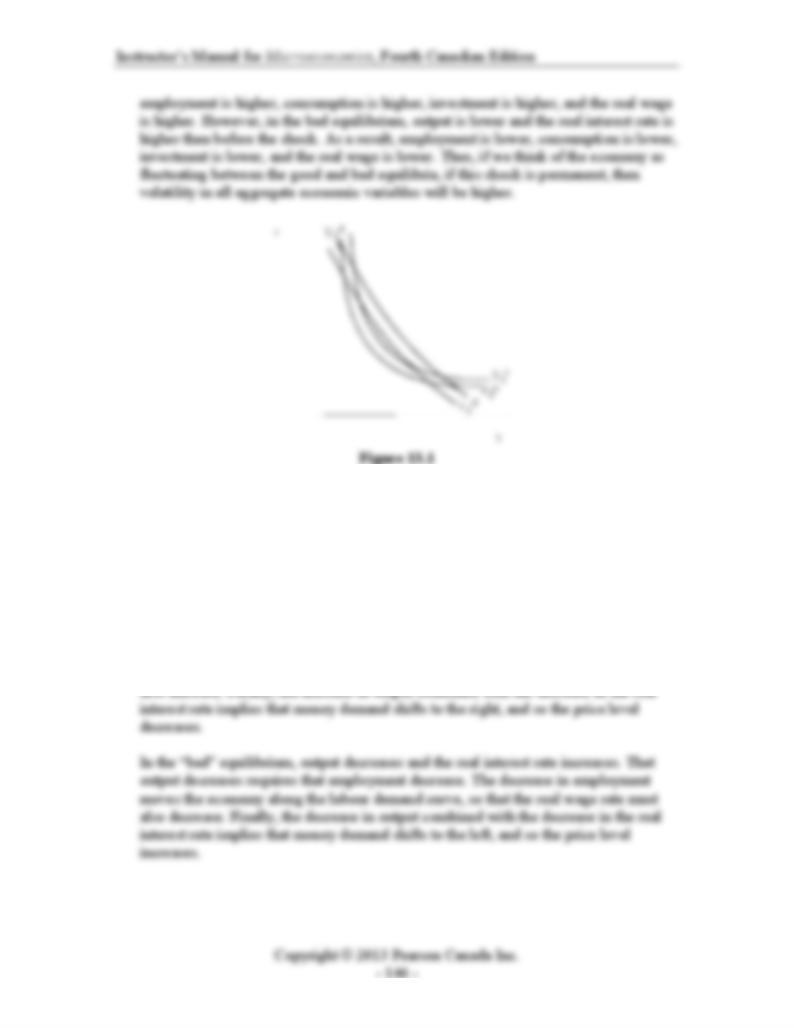
6. The permanent increase in government spending does not affect the aggregate
demand curve, because the increase in government spending generates an
approximately equal decrease in consumption. The implied increase in taxes shifts the
labour supply curve to the right. In the coordination failure model, this produces a
leftward shift in aggregate supply. Recall that the labour demand curve is upward
sloping and steeper than the labour supply curve. A leftward shift in aggregate supply
is depicted in Figure 13.2, below.
In the “good” equilibrium, output increases and the real interest rate decreases. That
output increases requires that employment increase. The increase in employment
moves the economy along the labour demand curve, so that the real wage rate must
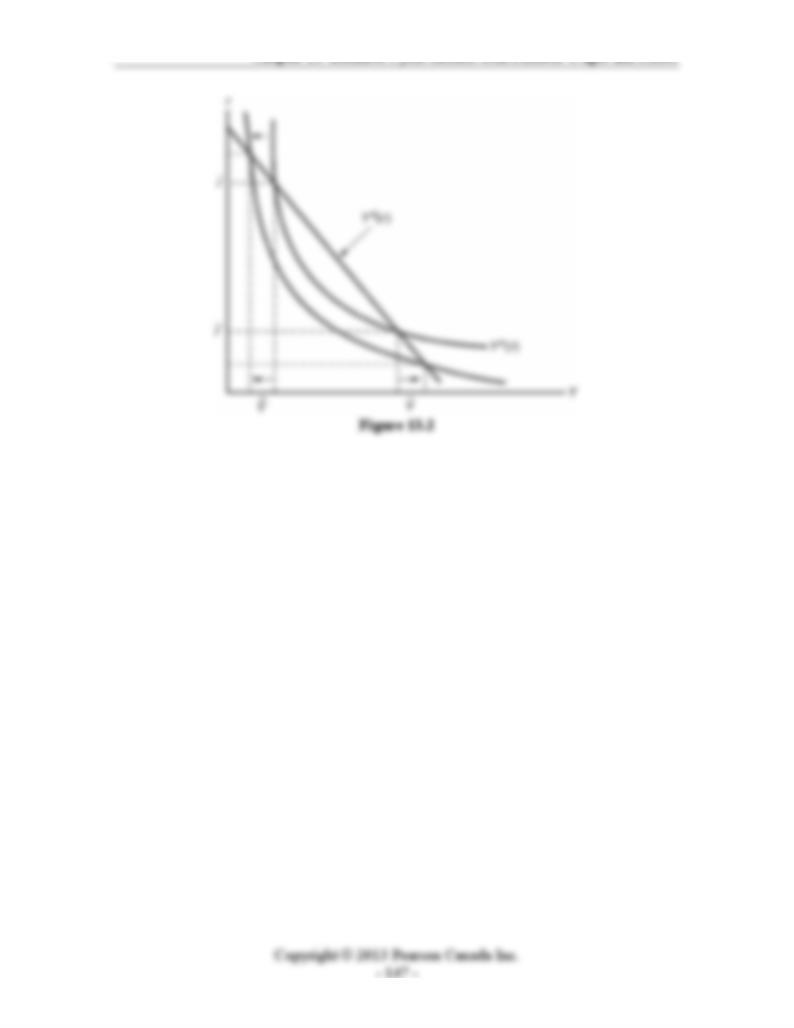
Chapter 13: Business Cycle Models with Flexible Wages and Prices
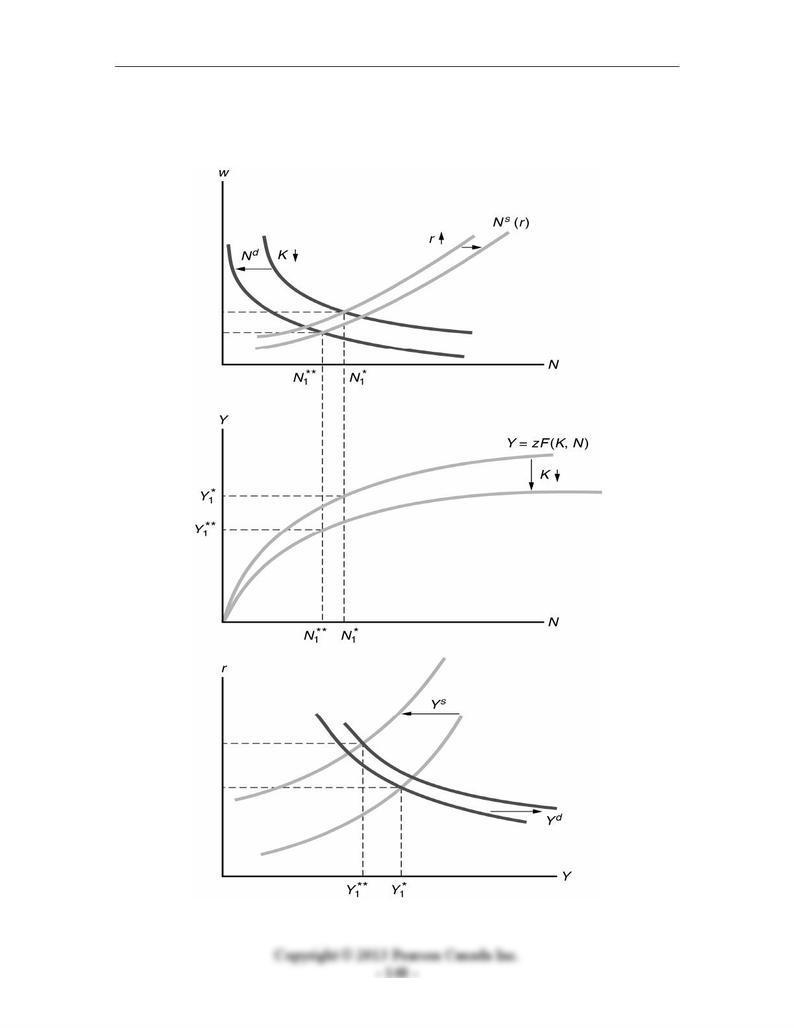
Instructor’s Manual for Macroeconomics, Fourth Canadian Edition
7. The effects of the decrease in the capital stock depend on the specific model we are
working with. The effect of the decrease in capital in the real business cycle is
depicted in Figure 13.3, below.
Figure 13.3
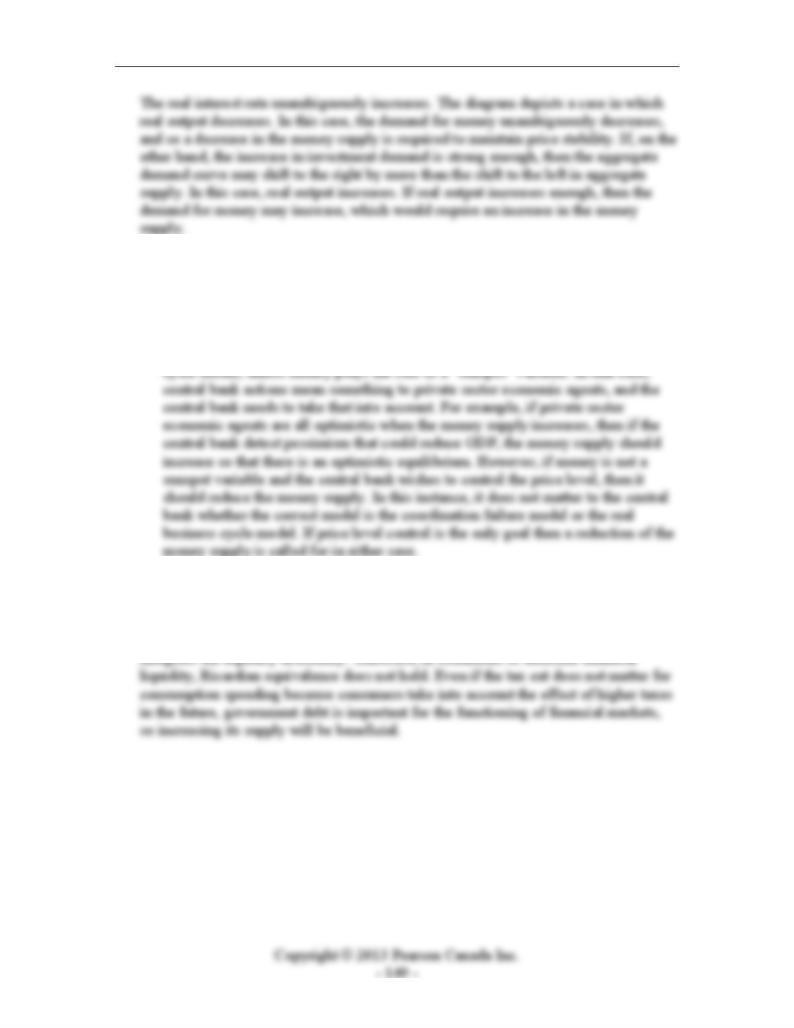
Chapter 13: Business Cycle Models with Flexible Wages and Prices
8. a) In the real business cycle model, what the central bank should do in response to a
decline in TFP depends on the central bank’s goals. If the central bank wishes to
stabilize the price level, then it should reduce the money supply, but money is
neutral in the real business cycle model, so there is no role for the central bank
other than price level control.
b) In the coordination failure model, money is neutral, just as in the real business
9. In the New Monetarist model, if there is deficient financial liquidity, then a tax cut
financed by an increase in the quantity of nominal government bonds, B, will increase
the quantity of liquid financial assets, a. This shifts the output demand curve to the
right, as in Figure 13.4, and the real interest rate and output both increase. This
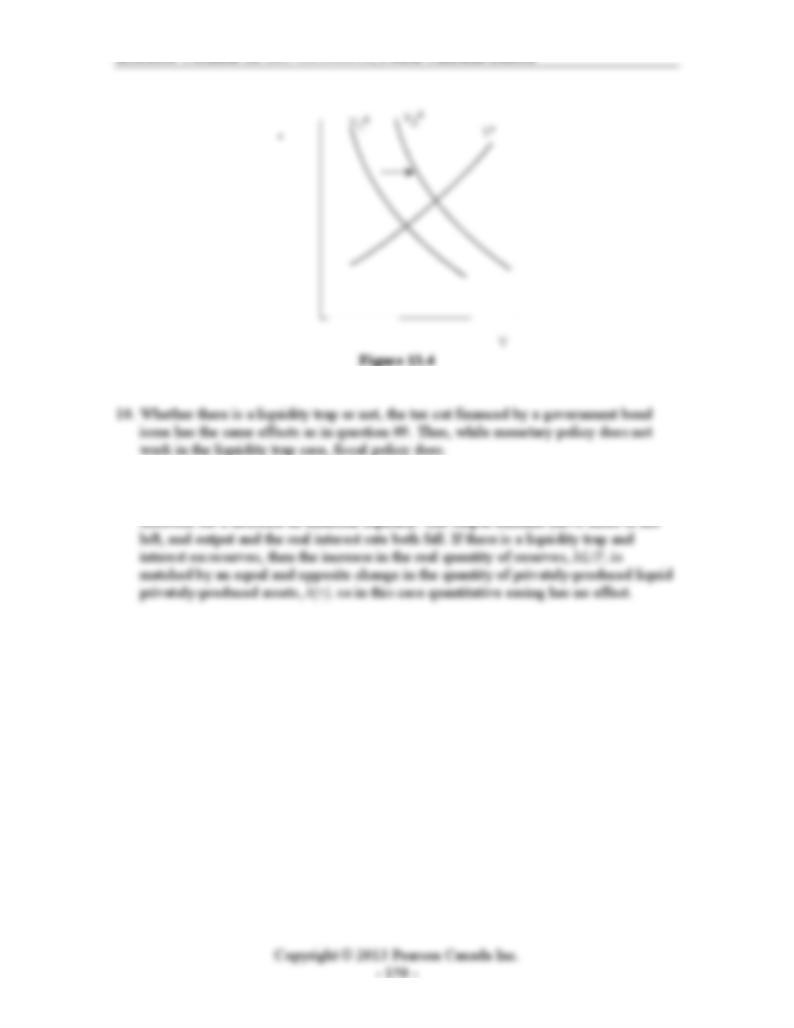
Instructor’s Manual for Macroeconomics, Fourth Canadian Edition
11. If there is deficient financial liquidity, then quantitative easing – an increase in M
matched by a decrease in k(r) – gives the same effects as in Figure 13.16 in the